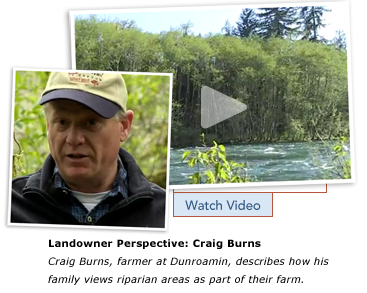Spend just a few moments in the riparian forest at Dunroamin, rambling under dappled sunlight with the gentle roar of the McKenzie River at your side, and you can understand why Craig Burns says his grandfather “found his Eden here.” Burns's grandparents, through with traveling the world, settled into this riverside property over 60 years ago. They added berry crops and fruit trees to the existing hazelnut trees before passing the farm on to their descendants. Since then the Burns family has lovingly tended the land and borne witness to the ever-changing life along the river.
On a spring day in such a peaceful place, it's easy to forget that keeping a riparian area healthy requires effort, even in an Eden like this one. Like many landowners, Craig Burns works continually to control invasive species, especially ivy, holly, Scotch broom, and vinca minor because, he explains, “We appreciate native vegetation and the wildlife species it provides for.”
The riparian area at Dunroamin amounts to about ten percent of the property. Maintaining it is important to the family for two main reasons. Burns explains, “We manage it to provide habitat for native plants and animals, and by doing so also provide a buffer or filter for our agricultural and domestic activities.” He adds that Dunroamin differs from many McKenzie River properties in that other riparian areas tend to be maintained with a manicured, park-like approach which can still filter pollutants if managed properly, though not as effectively as healthy natural riparian forest.
Some McKenzie River landowners, like the Burns family, are already committed to preserving riparian areas as part of their own land management practices. For those landowners the VIP offers the added benefit of financial compensation simply for maintaining those riparian areas in their native state. EWEB hopes that this added benefit will draw landowners into the program and provide motivation to maintain high quality riparian areas for the long term.
EWEB also hopes the added benefit will help landowners who want to maintain their riparian areas but struggle financially to do so. As Burns explains, “It's tough to make a living on a small farm nowadays, and so any benefit that we could get, any financial incentive would be a help.” He expects that any compensation realized from the VIP would be modest but may help, for example, with taxes on the riparian area.
For other McKenzie River landowners who have riparian areas not meeting program criteria, the VIP may provide motivation to improve their lands in order to enroll. Several organizations working in the McKenzie Basin offer assistance or rewards for landowners who work to improve the quality of their riparian areas. EWEB would like landowners to take advantage of those programs. Once they have completed restoration, EWEB hopes landowners will enroll in the VIP.
To enroll landowners and make the program a success, EWEB will have to prove to landowners that the VIP is worth their efforts. Craig Burns still has reservations, such as whether the program may carry so many restrictions that his family would choose not to enroll, but he also sees a potential side benefit. Thinking about the program's possibilities, he offers, “I think there should be a very strong science background to the program, and an educational program would be super. I've learned through 50 years down here what I think works to manage invasive species. I'm sure there are other people who have good ideas also.” Burns sees, like EWEB, that among the most valuable resources on the river – after the riparian areas themselves – are landowners and the knowledge they have earned from living there.

